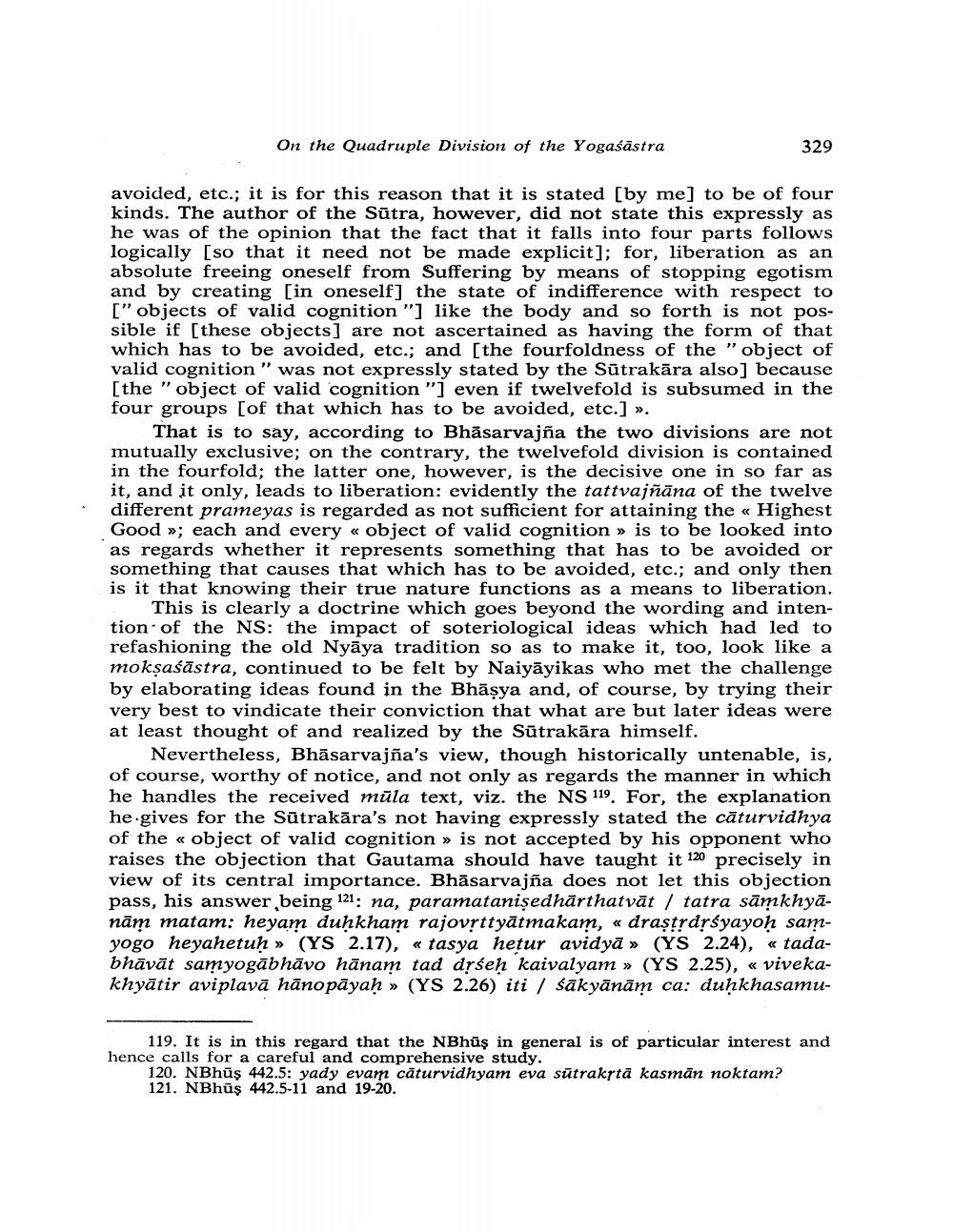________________
On the Quadruple Division of the Yogaśāstra
329
avoided, etc.; it is for this reason that it is stated [by me] to be of four kinds. The author of the Sūtra, however, did not state this expressly as he was of the opinion that the fact that it falls into four parts follows logically [so that it need not be made explicit]; for, liberation as an absolute freeing oneself from Suffering by means of stopping egotism and by creating [in oneself] the state of indifference with respect to ["objects of valid cognition "] like the body and so forth is not possible if [these objects] are not ascertained as having the form of that which has to be avoided, etc.; and (the fourfoldness of the " object of valid cognition" was not expressly stated by the Sūtrakāra also] because [the " object of valid cognition "] even if twelvefold is subsumed in the four groups (of that which has to be avoided, etc.] ».
That is to say, according to Bhāsarvajña the two divisions are not mutually exclusive; on the contrary, the twelvefold division is contained in the fourfold; the latter one, however, is the decisive one in so far as it, and it only, leads to liberation: evidently the tattvajñāna of the twelve different prameyas is regarded as not sufficient for attaining the « Highest Good »; each and every « object of valid cognition >> is to be looked into as regards whether it represents something that has to be avoided or something that causes that which has to be avoided, etc.; and only then is it that knowing their true nature functions as a means to liberation.
This is clearly a doctrine which goes beyond the wording and intention of the NS: the impact of soteriological ideas which had led to refashioning the old Nyāya tradition so as to make it, too, look like a mokşaśāstra, continued to be felt by Naiyāyikas who met the challenge by elaborating ideas found in the Bhāşya and, of course, by trying their very best to vindicate their conviction that what are but later ideas were at least thought of and realized by the Sūtrakāra himself.
Nevertheless, Bhāsarvajña's view, though historically untenable, is, of course, worthy of notice, and not only as regards the manner in which he handles the received mūla text, viz. the NS 119. For, the explanation he.gives for the Sūtrakāra's not having expressly stated the cāturvidhya of the < object of valid cognition is not accepted by his opponent who raises the objection that Gautama should have taught it 120 precisely in view of its central importance. Bhāsarvajña does not let this objection pass, his answer being 121: na, paramatanişedhārthatvāt / tatra sāmkhyānām matam: heyam duḥkham rajovsttyātmakam, « drastrdrsyayon samyogo heyahetuḥ » (YS 2.17), « tasya hetur avidyā » (YS 2.24), «tadabhāvāt samyogābhāvo hānam tad drśeh kaivalyam » (YS 2.25), « vivekakhyātir aviplavā hānopāyaḥ » (YS 2.26) iti / sākyānām ca: duḥkhasamu
119. It is in this regard that the NBhūs in general is of particular interest and hence calls for a careful and comprehensive study.
120. NBhūş 442.5: yady evam cāturvidhyam eva sūtrakrtā kasmān noktam? 121. NBhūş 442.5-11 and 19-20.




